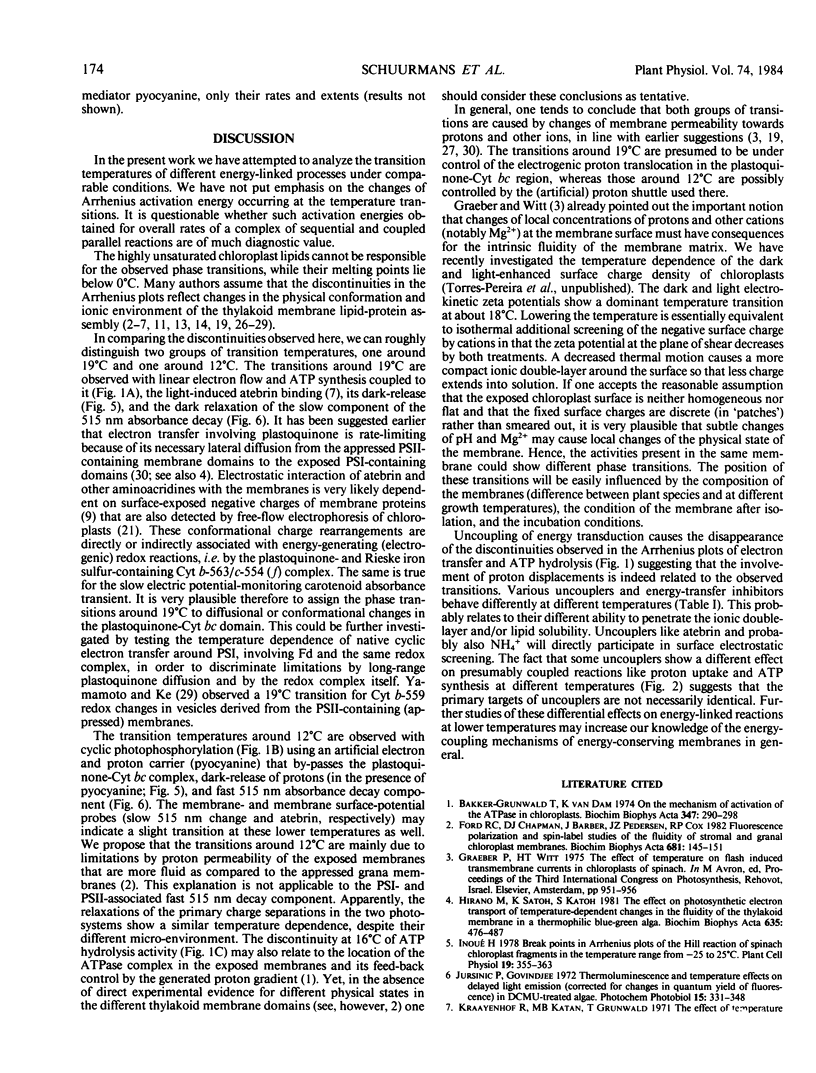Abstract
A comparative analysis of the temperature dependence of energy-transducing reactions in spinach (Spinacia oleracea) chloroplasts and their sensitivity for uncouplers and energy-transfer inhibitors at different temperatures is presented. Arrhenius plots reveal two groups of transitions, around 19°C and around 12°C. Activities that show transitions around 19°C include linear electron flow from water to ferricyanide, its coupled photophosphorylation, the dark-release of the fluorescent probe atebrin, and the slow component of the 515 nm (carotenoid) absorbance decay after a flash. The transitions around 12°C are observed with pyocyanine-mediated cyclic photophosphorylation, light- and dithioerythritol-activated ATP hydrolysis, the dark-release of protons, and the fast 515 nm decay component. It is suggested that both groups of temperature transitions are determined by proton displacements in different domains of the exposed thylakoid membranes. The effects of various uncouplers and an energy-transfer inhibitor are temperature dependent. Some uncouplers also show a different relative inhibition of proton uptake and ATP synthesis at lower temperatures. The efficiency of energy transduction (ATP/e2) varied with temperature and was optimal around 10°C.
Full text
PDF





Selected References
These references are in PubMed. This may not be the complete list of references from this article.
- Bakker-Grunwald T., van Dam K. On the mechanism of activation of the ATPase in chloroplasts. Biochim Biophys Acta. 1974 May 22;347(2):290–298. doi: 10.1016/0005-2728(74)90052-8. [DOI] [PubMed] [Google Scholar]
- Hirano M., Satoh K., Katoh S. The effect on photosynthetic electron transport of temperature-dependent changes in the fluidity of the thylakoid membrane in a thermophilic blue-green alga. Biochim Biophys Acta. 1981 May 13;635(3):476–487. doi: 10.1016/0005-2728(81)90107-9. [DOI] [PubMed] [Google Scholar]
- Jursinic P., Govindjee Thermoluminescence and temperature effects on delayed light emission (corrected for changes in quantum yield of fluorescence) in DCMU-treated algae. Photochem Photobiol. 1972 Apr;15(4):331–348. doi: 10.1111/j.1751-1097.1972.tb06244.x. [DOI] [PubMed] [Google Scholar]
- Kraayenhof R., Izawa S., Chance B. Use of uncoupling acridine dyes as stoichiometric energy probes in chloroplasts. Plant Physiol. 1972 Dec;50(6):713–718. doi: 10.1104/pp.50.6.713. [DOI] [PMC free article] [PubMed] [Google Scholar]
- Kraayenhof R., Schuurmans J. J., Valkier L. J., Veen J. P., Van Marum D., Jasper C. G. A thermoelectrically regulated multipurpose cuvette for simultaneous time-dependent measurements. Anal Biochem. 1982 Nov 15;127(1):93–99. doi: 10.1016/0003-2697(82)90149-x. [DOI] [PubMed] [Google Scholar]
- Kumamoto J., Raison J. K., Lyons J. M. Temperature "breaks" in Arrhenius plots: a thermodynamic consequence of a phase change. J Theor Biol. 1971 Apr;31(1):47–51. doi: 10.1016/0022-5193(71)90120-2. [DOI] [PubMed] [Google Scholar]
- McEvoy F. A., Lynn W. S. The effects of temperature on photophosphorylation and on the two forms of cytochrome 559 in subchloroplast particles. Arch Biochem Biophys. 1972 Jun;150(2):632–635. doi: 10.1016/0003-9861(72)90083-5. [DOI] [PubMed] [Google Scholar]
- Murata N., Fork D. C. Temperature dependence of the light-induced spectral shift of carotenoids in Cyanidium caldarium and higher plant leaves. Evidence for an effect of the physical phase of chloroplast membrane lipids on the permeability of the membrane to ions. Biochim Biophys Acta. 1977 Sep 14;461(3):365–378. doi: 10.1016/0005-2728(77)90226-2. [DOI] [PubMed] [Google Scholar]
- NISHIMURA M., ITO T., CHANCE B. Studies on bacterial photophosphorylation. III. A sensitive and rapid method of determination of photophosphorylation. Biochim Biophys Acta. 1962 May 7;59:177–182. [PubMed] [Google Scholar]
- Nolan W. G. Effect of temperature on electron transport activities of isolated chloroplasts. Plant Physiol. 1980 Aug;66(2):234–237. doi: 10.1104/pp.66.2.234. [DOI] [PMC free article] [PubMed] [Google Scholar]
- Nolan W. G. Effect of temperature on proton efflux from isolated chloroplast thylakoids. Plant Physiol. 1981 Jun;67(6):1259–1263. doi: 10.1104/pp.67.6.1259. [DOI] [PMC free article] [PubMed] [Google Scholar]
- Nolan W. G., Smillie R. M. Multi-temperature effects on Hill reaction activity of barley chloroplasts. Biochim Biophys Acta. 1976 Sep 13;440(3):461–475. doi: 10.1016/0005-2728(76)90034-7. [DOI] [PubMed] [Google Scholar]
- Nolan W. G., Smillie R. M. Temperature-induced Changes in Hill Activity of Chloroplasts Isolated from Chilling-sensitive and Chilling-resistant Plants. Plant Physiol. 1977 Jun;59(6):1141–1145. doi: 10.1104/pp.59.6.1141. [DOI] [PMC free article] [PubMed] [Google Scholar]
- Schapendonk A. H., Hemrika-Wagner A. M., Theuvenet A. P., Sang H. W., Vredenberg W. J., Kraayenhof R. Energy-dependent changes of the electrokinetic properties of chloroplasts. Biochemistry. 1980 Apr 29;19(9):1922–1927. doi: 10.1021/bi00550a030. [DOI] [PubMed] [Google Scholar]
- Shneyour A., Raison J. K., Smillie R. M. The effect of temperature of the rate of photosynthetic electron transfer in chloroplasts of chilling-sensitive and chilling-resistant plants. Biochim Biophys Acta. 1973 Jan 18;292(1):152–161. doi: 10.1016/0005-2728(73)90259-4. [DOI] [PubMed] [Google Scholar]
- Torres-Pereira J., Mehlhorn R., Keith A. D., Packer L. Changes in membrane lipid structure of illuminated chloroplasts: studies with spin-labeled and freeze-fractured membranes. Arch Biochem Biophys. 1974 Jan;160(1):90–99. doi: 10.1016/s0003-9861(74)80012-3. [DOI] [PubMed] [Google Scholar]
- Yamamoto Y., Ford R. C., Barber J. Relationship between Thylakoid Membrane Fluidity and the Functioning of Pea Chloroplasts : EFFECT OF CHOLESTERYL HEMISUCCINATE. Plant Physiol. 1981 Jun;67(6):1069–1072. doi: 10.1104/pp.67.6.1069. [DOI] [PMC free article] [PubMed] [Google Scholar]


